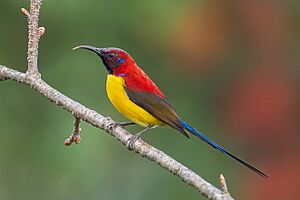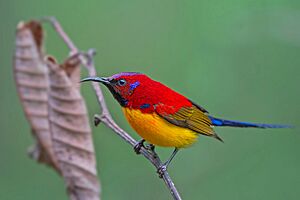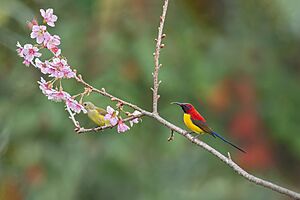Mrs. Gould's sunbird facts for kids
Quick facts for kids Mrs. Gould's sunbird |
|
|---|---|
 |
|
| Aethopyga gouldiae in Nagarkot, Nepal. | |
| Conservation status | |
| Scientific classification | |
| Genus: |
Aethopyga
|
| Species: |
gouldiae
|
The Mrs. Gould's sunbird (Aethopyga gouldiae) is a beautiful, small bird. It is a type of sunbird. This bird lives in forests and shrublands. You can find it from the southern parts of the Himalayas mountains all the way to Southeast Asia.
Contents
About Mrs. Gould's Sunbird
This sunbird was first described by a scientist named Nicholas Vigors in 1831. He named it after a talented British bird artist, Elizabeth Gould.
There are four slightly different types, or subspecies, of Mrs. Gould's sunbird. They are:
- A. g. annamensis
- A. g. dabryii
- A. g. gouldiae
- A. g. isolata
This species is thought to be closely related to the green-tailed sunbird.
What Does It Look Like?
Mrs. Gould's sunbird is a small bird. It has a beak that curves downwards and is pointed. This special beak helps it drink nectar from flowers. Its eyes are usually dark brown, and its legs are black.
The male Mrs. Gould's sunbird is very bright and colorful. Its head, throat, and eyebrows are a deep violet color. The sides of its face, neck, and back are bright red. You might also see bright blue patterns on its face. Its wings are brown or olive green. The belly is yellowish-green. The tail is bright blue and turns dark purple at the tip.
The female bird is not as colorful as the male. She is mostly deep olive green on her back. Her belly is a grayish-yellow color.
The colors and patterns can be a bit different depending on the subspecies. For example, the A. g. dabryii subspecies has a purely red chest. The A. g. gouldiae subspecies has a bright yellow chest, sometimes with a red stripe.
Male Mrs. Gould's sunbirds weigh about 4 to 12 grams. They are about 13 to 16 centimeters long. Their wings are 5 to 5.8 cm long, and their tails are 6.4 to 8.8 cm long. Females are smaller, weighing 5 to 8 grams and measuring 9 to 11 cm long. Their wings are 4.5 to 5.4 cm long, and their tails are 3 to 4 cm long. Both males and females have beaks that are about 1.3 to 1.7 cm long.
Where Do They Live?
Mrs. Gould's sunbird lives in many countries. These include Bangladesh, Bhutan, Laos, Myanmar, Nepal, Thailand, India, Vietnam, and Southern China. They live in different types of forests. These can be evergreen forests, monsoon forests, or deciduous forests. They are usually found at high altitudes, from 1000 to 3500 meters above sea level. Sometimes, you can also spot them in fruit orchards and bamboo forests. There is also a group of these birds that lives in Hong Kong during the non-breeding season.
What Do They Eat?
Like other sunbirds, Mrs. Gould's sunbird mostly eats nectar from flowers. They have a long, tube-shaped tongue. This tongue is perfect for sucking nectar from deep flowers. They also eat small insects and spiders. In some areas, they have been seen eating small beetles and tiny insect nymphs.
How Do They Behave?
Mrs. Gould's sunbirds usually stay in the same area. But sometimes, they might move short distances during different seasons. You will often see them alone or in pairs. Sometimes, small groups of 3 to 5 birds can form. Occasionally, even more than 10 birds might gather together. They move very quickly and fly short distances. Their calls sound like a high, thin "tzeeee" or a sharp "tzit".
Reproduction and Life Cycle
The breeding season for Mrs. Gould's sunbird is from April to June. Female birds usually start building their nests around mid-April. The nest is made from moss, grass, plant fibers, and spiderwebs. It is about 15 to 18 cm long and 10 to 11.5 cm wide. Nests are often built in deciduous forests at heights of 1000 to 3000 meters above sea level.
During the breeding season, male birds try to attract females with a special mating call, "zhai-zhai-zhai". A female usually lays 2 or 3 eggs. The eggs are white and often have reddish-brown spots. The eggs hatch after about two weeks. The baby birds leave the nest after about 15 to 16 days. Both parents take care of the chicks. At first, the adults feed the young chicks nectar. Later, they start feeding them more insects.
Conservation Status
The Mrs. Gould's sunbird is listed as "Least Concern" by the IUCN Red List. This means that it is not currently considered to be in danger of disappearing.
In China, this bird is not on the list of endangered species. However, it is on a list of wild animals that are protected because they are beneficial or important for science.




